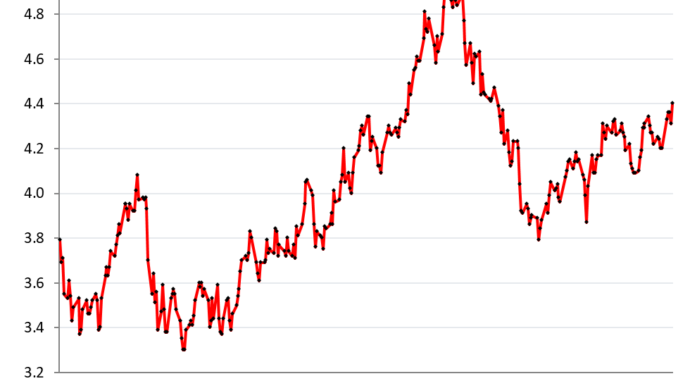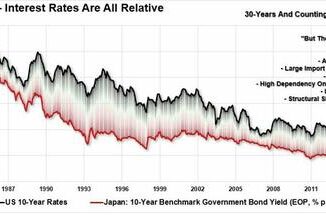
Suddenly lots of talk the 10-year yield will revisit 5%, which is funny just a few months after Rate-Cut Mania.
By Wolf Richter for WOLF STREET.
The 10-year Treasury yield rose to 4.40% on Friday, the highest since November 27. During rate-cut mania in December, the yield had dropped below 3.80%.
Those moves in recent days and weeks added up, and they point to a gradual recognition in the bond market that inflation rates will be higher than what they’d been before the pandemic, that 2% inflation isn’t going to happen, and that the super-low interest-rate environment over the past 15 years – culminating in August 2020 when the 10-year yield was down to 0.5% – is over.
What comes next is unknown, but it’ll likely entail higher inflation of the type seen in the 1990s and before because the Fed isn’t willing to crash the economy and the labor market just to get to 2% inflation.
That means the Fed will keep its policy rates fairly high – high enough to not let inflation spiral out of control, but not so high as to crash the economy and bring inflation down to 2% – and yields will be higher too to compensate for the higher inflation, everything will be higher, like it used to be, and the bond market is adjusting to that scenario.
Now there’s suddenly lots of talk that the 10-year yield will revisit 5%, where it had briefly been in October, because inflation will be higher for longer, or forever, which is funny after Rate-Cut Mania, and the yield would have to compensate for inflation over the 10-year period, plus some.
Obviously, “forever” here doesn’t mean forever in the cosmic sense, but in the bond sense, meaning beyond the maturity date of the bond.
It’s interesting how the narrative in the market changed so quickly. From November into mid-January, there was the Rate-Cut Mania, with the market for federal funds futures seeing very high probabilities of five and six rate cuts and even seven rate cuts in 2024, spread over the eight Fed meetings.
And then the Fed started pushing back. It came out with a doozie of a push-back FOMC statement after its January meeting, and repeated it at its March meeting. And we had two awful inflation readings in January and February, on top of the upward trend of the underlying metrics that started last fall.
The “dot plot” from the March FOMC meeting showed that the 19 participants were nearly evenly split, with 9 seeing two rate cuts in 2024, and 9 seeing three rate cuts, and 1 seeing four cuts, leaving the median at three cuts. But if only one of the three-cutters becomes a two-cutter by the June dot plot, then a two-cuts scenario comes out of that meeting. This March “dot plot” was a warning sign that those three rate cuts may vanish.
Since then, lots of Fed officials gave speeches, fretting about the path of inflation, and walking back their own rate-cut expectations.
Yesterday, Minneapolis Fed President Kashkari said the quiet part out loud: Maybe there won’t be any rate cuts in 2024 if inflation keeps going “sideways.”
Today Fed governor Bowman came out and said out loud: “While it is not my baseline outlook, I continue to see the risk that at a future meeting we may need to increase the policy rate further should progress on inflation stall or even reverse.”
They’re talking about short-term policy rates, not longer-term yields. And they’re fretting that something big has changed in the economy: That even the 5.25% to 5.5% short-term policy rates, that were supposed to be “restrictive” and that were widely expected to throw the economy into a recession, have not been restrictive and have not slowed the economy.
On the contrary, economic growth and the labor market accelerated in 2023, and the labor market has maintained its rapid growth so far in 2024, creating jobs at a rate of 3.3 million a year in the first quarter, which is hot, and hotter than it was in 2023. And financial conditions have eased, and markets are in la-la-land.
And so folks are wondering what kind of policy rate would actually be “restrictive” if 5.5% at the current inflation rates is not restrictive. If inflation on a three-month basis and six-month basis is 4% or 5%, where would policy rates have to be to be restrictive?
The three-month core CPI accelerated to 4.2% annualized, the highest since May 2023, and the three-month core services CPI accelerated to 5.6%.
Policy rates are 5.25% to 5.50%. They need to be higher than inflation rates to be restrictive; there is widespread agreement on that. Just how much higher is uncertain.
There are a lot of inflation measures in the US. But if we use the three-month measure of core CPI, which was 4.2% in February, neutral policy rates might be 6.0%, and anything below would still be stimulative.
Obviously, everyone is just guessing. Inflation has come down a lot, but now it’s heading higher again. The path of inflation is very uncertain, as we have seen. It could turn around and go down again, but that seems unlikely now. Inflation frequently dishes out head-fakes.
The economy and the labor market have been growing at an above-average pace, and yet policy rates have been above 5% since May 2023 and above 4% since December 2022. With that kind of growth, and the inflation we have, they’re not restrictive.
And the bond market is adjusting to this scenario and it seems is just heading back to the old normal – the normal from 20 or 30 years ago, as we can see in the long-term chart:
Enjoy reading WOLF STREET and want to support it? You can donate. I appreciate it immensely. Click on the beer and iced-tea mug to find out how:
Would you like to be notified via email when WOLF STREET publishes a new article? Sign up here.

